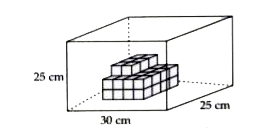A small indoor greenhouse (herbarium) is made entirely of glass panes (including base) held together with tape. It is 30 cm long, 25 cm wide and 25 cm high.
(i) What is the area of the glass?(ii) How much of tape is needed for all the 12 edges?
(i) Total S.A of green house
SA=2(lb+bh+lb)
SA=2(30×25+30×25+25×25)=4250cm2
(ii) For 12 edges.
Total length=4l+4b+4h
TL=4(30+25+25)=320cm
Topper's Solved these Questions
- SURFACE AREAS AND VOLUMESBook:NCERTChapter:SURFACE AREAS AND VOLUMESExercise:EXERCISE 13.2
Explore 11 Videos
- SURFACE AREAS AND VOLUMESBook:NCERTChapter:SURFACE AREAS AND VOLUMESExercise:EXERCISE 13.8
Explore 10 Videos
- SURFACE AREAS AND VOLUMESBook:NCERTChapter:SURFACE AREAS AND VOLUMESExercise:SOLVED EXAMPLES
Explore 19 Videos
- STATISTICSBook:NCERTChapter:STATISTICSExercise:EXERCISE 14.1
Explore 2 Videos
- TRIANGLESBook:NCERTChapter:TRIANGLESExercise:EXERCISE 7.2
Explore 8 Videos
Similar Questions
A small indoor greenhouse (herbarium) is made entirely of glass panes (including base) held together with tape. It is 30 cm long, 25 cm wide and 25 cm high.
(i) What is the area of the glass?(ii) How much of tape is needed for all the 12 edges?
View SolutionA cubical box has each edge 10 cm and another cuboidal box is 12.5 cm long, 10 cmwide and 8 cm high.(i) Which box has the greater lateral surface area and by how much?(ii) Which box has the smaller total surface area and by how much?
View Solution
Knowledge Check
A small indoor greenhouse (herbarium) is made entirely of glass panes (including base) held togther with tape. It is 30 cm long, 25 cm wide and 25 cm high.
What is the area of the glass ?A5000cm2B4800cm2C4250cm2D4500cm2Kunal arranged some metal blocks at the bottom of a tank as seen in the figure below. Then he filled the 30 cm by 25 cm by 25 cm tank with water. If each block is 4 cm long, 3 cm wide and 5 cm tall, then how much water is needed to fill the tank to 80% of the tank's height?
 A15000 cm3B2280 cm3C12720 cm3D16470 cm3
A15000 cm3B2280 cm3C12720 cm3D16470 cm3The given question is followed by three statements labelled I, II and III. You have to study the question and all the three statements given do decide whether any information provided in the statement(s) is/are redundant and can be dispensed with while answering the given question.
What is the area of the given rectangle?
I. Perimeter of the rectangle is 60 cm.
II. Breadth of the rectangle is 12 cm.
III. Sum of two adjacent sides is 30 cm.AI onlyBII onlyCIII onlyDI or III only
A closed aquarium of dimensions 30cm×25cm×20cm is made up entirely of glass plates held together with tapes. The total length of tape required to hold the plates together (ignore the overlapping tapes) is (a) 75 cm (b) 120 cm (c) 150 cm (d) 300 cm
View SolutionHow many square metres of glass will be required for a window, which has 12 panes, each pane measuring 25 cm by 16 cm?
View SolutionA card sheet divided into squares each of size 1mm2 is being viewed at a distance of 9 cm through a magnifying glass (a converging lens of focal length 9 cm) held close to the eye.
(a) What is the magnification produced by the lens ? How much is the area of each square in the virtual image ?
(b) What is the angular magnification (magnifying power) of the lens ?
(c) Is the magnification in (a) equal to the magnifying power in (b) ? Explain.
View SolutionA cardsheet divided into squares each of size 1mm2 is being viewed at a distance of 9cm through a magnifying glass (a conerging lens of focal length 10cm) held close to the eye.
(a) What is the magnification produced by the lenas ? How much is the area of each square to the virtual image ?
(b) What is the angular magnification (magnifying power) of the lens ?
( c) Is the magnification in (a) equal to the magnifying power in (b) ? Explain
View SolutionA figure divided into squares, each of size 1 mm2, is being viewed at a distance of 9 cm through a magnifying lens of focal length 10 cm, held close to the eye.
(i) Draw a ray diagram showing the formation of the image.
(ii) What is the magnification produced by the lens? How much is the area of each square in the virtual image?
(iii) What is the angular magnification of the lens?
View Solution